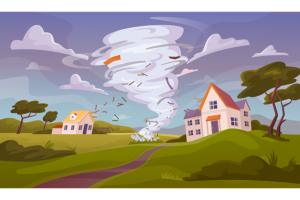In an era where natural disasters seem to be on the rise, having a home insurance policy that adequately covers these events is more crucial than ever. As a homeowner, you may find yourself facing hurricanes, earthquakes, wildfires, or other calamities depending on where you live. Today we’ll walk you through the steps to ensure your home insurance policy is disaster-proof, providing you peace of mind knowing that your most significant investment is protected
Understanding Regional Risks
1. Assess Your Location: Begin by understanding the natural disasters most common in your area. Each region has its specific risks—hurricanes in the Gulf Coast, wildfires in the West, tornadoes in the Midwest, or earthquakes along the Pacific Rim. Recognizing these risks is the first step in tailoring your home insurance policy.
2. Research Historical Data: Consult local government resources, historical data, and climate reports to understand the frequency and impact of disasters in your region. This information can guide you in deciding the extent of coverage you need.
Tailoring Your Coverage
- Standard Policy Limitations: Most standard home insurance policies cover events like windstorms and fires, but be wary—they often exclude earthquakes and floods. You need to know exactly what your current policy covers and where it falls short.
- Add Necessary Riders: For disasters not covered under your standard policy, such as earthquakes and floods, you’ll likely need to add specific riders or purchase separate policies. For example, homeowners in flood-prone areas should consider policies from the National Flood Insurance Program (NFIP).
- Understand Replacement Costs: Ensure your policy includes coverage for the replacement costs of your home, not just the current market value. Replacement cost coverage ensures you can rebuild your home at today’s construction prices without being out of pocke Enhancing Your Policy’s Effectiveness
- Review Your Deductibles: Natural disaster policies often come with higher deductibles. You might opt for a higher deductible to lower your premiums, but ensure this amount is manageable for you financially in case of a disaster.
- Regularly Update Your Policy: As your home increases in value or as you make significant improvements (e.g., building an addition, renovating, or installing protective features), update your insurance coverage accordingly. Failing to do so could leave you underinsured when disaster strikes.
Preparing Beyond Insurance
- Mitigate Risks: Take proactive steps to minimize potential damage. This can include installing storm shutters, reinforcing your roof, retrofitting foundations for earthquake resistance, or creating defensible space around your property to protect against wildfires.
- Document Everything: Keep a detailed inventory of your home’s contents and any upgrades or repairs. Take photos or videos as proof. Store these records in a safe place, ideally off-site or in cloud storage, to simplify the claims process after a disaster.
- Plan for the Worst: Have an emergency plan for your family, including evacuation routes, emergency contacts, and a communication plan. Knowing what to do when a disaster strikes can be just as important as having the right insurance coverage.
Conclusion
Disaster-proofing your home insurance policy isn’t just about buying coverage—it’s about understanding your risks, choosing the right options, and being proactive in home management. By following these steps, you can secure peace of mind, knowing that no matter what nature throws your way, your home, the heart of your family’s financial security, is well-protected.



